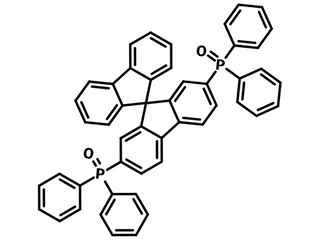SPPO13
CAS Number 1234510-13-4
Host Materials, Materials, OLED Materials, Phosphorescent Host Materials,SPPO13, n-type solution-processable ETL material
Universal bipolar co-host for blue, green and red phosphors
SPPO13, 2,7-Bis(diphenylphosphoryl)-9,9'-spirobifluorene, has a structure with an electron donating spirobifluorene core surrounded by two identical electron withdrawing diphenylphosphine oxide groups, while SPPO1 has only one diphenylphosphine oxide group attached to the spirobifluorene.
Due to its electron deficient nature, SPPO13 is used as an n-type solution-processable electron transporting material. SPPO13 could also be used as universal bipolar co-host for blue, green and red phosphors while blending with hole transporting materials such as tris(4-carbazoyl-9-ylphenyl)amine (TCTA).
General Information
| CAS number | 1234510-13-4 |
| Full name | 2,7-Bis(diphenylphosphoryl)-9,9'-spirobifluorene |
| Chemical formula | C49H34O2P2 |
| Molecular weight | 716.74 g/mol |
| Absorption | λmax 282 nm (in DCM) |
| Phosphorescene | λmax 373 nm (in DCM) |
| HOMO/LUMO | HOMO 5.90 eV, LUMO 2.60 eV [1] |
| Synonyms | 9,9'-spirobi[fluorene]-2,7-diylbis(diphenylphosphine oxide) |
| Classification / Family | Spirobifluorene derivatives, TADF Light-emitting diodes, Organic electronics, Electron transport Layer (ETL), PHOLEDs cohost materials, Sublimed materials. |
Product Details
| Purity | >99.0% (HPLC) |
| Melting point | Tg = 123°C |
| Appearance | White powder/crystals |
Chemical Structure
Device Structure(s)
| Device structure | ITO/PEDOT:PSS (40 nm)/PTPATPPO:Ir(2-phq)2acac* (60 nm) (2 wt%)/SPPO13 (70 nm)/Al (100 nm) [2] |
| Color |
|
| Max. Power Efficiency | 42.7 lm W-1 |
| Max. EQE | 6.1% |
| Device structure | ITO/PEI:Li2CO3/SPPO13:TCTA:FIrPic/TCTA/MoO3/Al [3] |
| Color |
|
| Max. Current Efficiency | 34.3 cd/A |
| Max. Power Efficiency | 20.5 lm W-1 |
| Max. EQE | 15.2% |
| Device structure | ITO/PEI:Li2CO3/SPPO13:TCTA:Ir(mppy)3/TCTA/MoO3/Al [3] |
| Color |
|
| Max. Current Efficiency | 56.9 cd/A |
| Max. Power Efficiency | 35.4 lm W-1 |
| Max. EQE | 16.3% |
| Device structure | ITO/PEI:Li2CO3/SPPO13:TCTA:Ir(MDQ)2(acac)/TCTA/MoO3/Al [3] |
| Color |
|
| Max. Current Efficiency | 12.0 cd/A |
| Max. Power Efficiency | 7.9 lm W-1 |
| Max. EQE | 10.8% |
*For chemical structure information, please refer to the cited references.
Pricing
| Grade | Order Code | Quantity | Price |
| >99.0% purity (HPLC) | M2333A1 | 250 mg | £400 |
| >99.0% purity (HPLC) | M2333A1 | 500 mg | £660 |
| >99.0% purity (HPLC) | M2333A1 | 1 g | £1150 |
MSDS Documentation
Literature and Reviews
- An Amorphous Spirobifluorene-Phosphine-Oxide Compound as the Balanced n-Type Host in Bright and Efficient Light-Emitting Electrochemical Cells with Improved Stability, S. Tang et al., Adv. Optical Mater., 9, 2002105 (2021); DOI: 10.1002/adom.202002105..
- A novel blue fluorescent polymer for solution-processed fluorescent–phosphorescent hybrid WOLEDs, J. Wang et al., J. Mater. Chem. C, 3, 2856 (2015); DOI: 10.1039/c4tc02899f.
- Solution-processable small molecules as efficient universal bipolar host for blue, green and red phosphorescent inverted OLEDs. J. Chen et al., J. Mater. Chem., 22, 5164-5170 (2012); DOI: 10.1039/C2JM16463A.
- High power efficiency in simplified two layer blue phosphorescent organic light-emitting diodes, S. Jang et al., Org. Electronics 11 (6), 1154-1157 (2010); DOI: 10.1016/j.orgel.2010.04.004.
- Fabrication and Efficiency Improvement of Soluble Blue Phosphorescent Organic Light-Emitting Diodes Using a Multilayer Structure Based on an Alcohol-Soluble Blue Phosphorescent Emitting Layer, K. Yook et al., Adv. Mater., 22 (40), 4479-4483 (2010); DOI: 10.1002/adma.201002034.
- Small Molecule Approach to Passivate Undercoordinated Ions in Perovskite Light Emitting Diodes: Progress and Challenges, J. Lee et al., Adv. Optical Mater., 10 (1), 2101361 (2021); DOI: 10.1002/adom.202101361.

